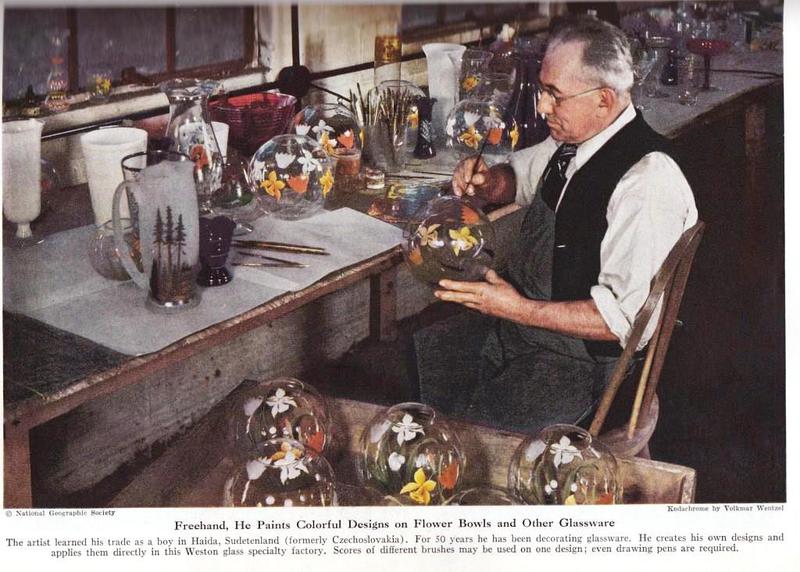Josef Henke Hand-Painted China
Josef Henke, a Nationally Famous Kalamazoo Artist
Josef Henke, pronounced Hen'-kee, (1875-1965) was born in Haida (in what was then Czechoslovakia) where he began learning his trade as a painter of fine china at the age of 14. In 1899, he married the woman who would be his wife of 65 years, Hedwig Rasche Henke. He, with his wife and sons, came to the United States in about 1903 and had no trouble finding work as his craft was much appreciated at that time. He came to Kalamazoo, Michigan, to work for the D’Arcy Studio, who sold jewelry and glassware. He was one of two painters who produced fine hand-painted china for this company. The other painter, last name Shindler/Schindlar (sp?), was said to be a very fine artist, but he was not as productive as Mr. Henke. Later, Henke painted independently, working at his home, and did work for the Weisley Company of Kalamazoo as well as for New York and Chicago wholesale glass firms. Therefore, Henke’s work is more easily found and more readily collectable.
Henke and his wife had five children, four sons and a daughter. An early home was on Edwards Street in Kalamazoo, where by 1915, Josef set up production, working in the living room, dining room, and basement. He often did special order work, making complete sets of china according to client specifications, painting fruit, flowers, vegetables, landscapes, hunting scenes, etc. Later the family moved to 324 N. Riverview Drive in Parchment where he continued his fine art work for many years.
For about five years during World War II, when he could not get his fine Bavarian blank china, Henke and his family moved to West Virginia where he found work as a glass painter (see photo). When the war was over, he and his family returned to the Kalamazoo area.
Henke signed nearly every individual piece of his work “JHENKE.” Some smaller pieces, such as toothpick holders and other miniatures, were signed with just a “JH,” and rarely, if pieces were a set, such as cup and saucer or sugar and creamer, he would sign only part of the set: sign the cup but not the saucer, or not sign a lid, etc. For a short time, due to a copyright dispute (I believe between D’Arcy and Weisley) over his signature, Henke signed some of his pieces “LEO.”
Josef Henke worked at his craft well into his 80s. He had built a national reputation as a fine artist and a quality craftsman. “He died in Kalamazoo in 1965, leaving a legacy of hand-painted china that, with a little treasure hunting, can still be found in antique stores and flea markets [and online] throughout the United States.”—quoted from an article in the Spring 2012 issue of MuseOn magazine, pages 12-13.
Sources: Article in June 23, 1957, Kalamazoo Gazette. Henke obituary from May 30, 1965, Kalamazoo Gazette. Information also came from some Kalamazoo Henke collectors. You can find the total copy of the Spring 2012 MuseOn Magazine online: http://kvm.kvcc.edu/info/museON/museographies/MuseOn_Spring2012_ISSUU_1.pdf [sic: the word ISSUE is ISSUU in the actual link.] Scroll down to pages 12 and 13. This article shows Carolyn Martin’s small collection, which was on display at the Museum at that time. Some pieces have been added to the collection since then.
Biography for this website by Carolyn Martin, October 2016 using above sources.
This website is intended to be a showcase for some J. Henke hand-painted china collections. If the pieces are for sale, a price will be in the lower right corner below each picture. If not, NFS (not for sale) will be there. Occasionally a collector may tell you how much s/he paid for a piece along with where it was purchased. Please do not confuse this with a for sale price. If a piece appears to be misshaped, such as not quite round or not quite square, realize that the camera angle may be distorting the shape.
If you are a collector and would like your collection to be added to this site, contact Carolyn Martin <carmartin62@sbcglobal.net> .
Consider that a piece is signed “JHENKE” unless a different signature is given in quotes (“LEO” or “JH”) or it is captioned as unsigned. If you are considering purchasing a piece and the signature does not show in the photo, you should double check signature with the seller since this detail might have been overlooked in posting on the site.
Most pieces are stamped on the bottom with a Bavarian china company name or just “Bavaria” unless otherwise noted. Not every collector recorded this information.
The initials of the collector and a number has been assigned to each piece for purposes of clarity when discussing any piece. These numbers are used on this website only and are not from any official source.
Measurements given under each piece are in inches for height (table to highest point of piece) or for diameter unless mentioned otherwise.
Kalamazoo Gazette photo
Photo from the August 1940 edition of THE NATIONAL GEOGRAPHIC MAGAZINE as shown in inserted photo (lower left). Photo was taken when Josef Henke was living and working in West Virginia during World War II.
 | ||||||
 | ||||||
INDEX for this website:
Home page, Josef Henke biography and website information.
Photo Gallery 1, Carolyn Martin Collection and
Marilyn Cowell Collection
Photo Gallery 2, Harmony House Collection


